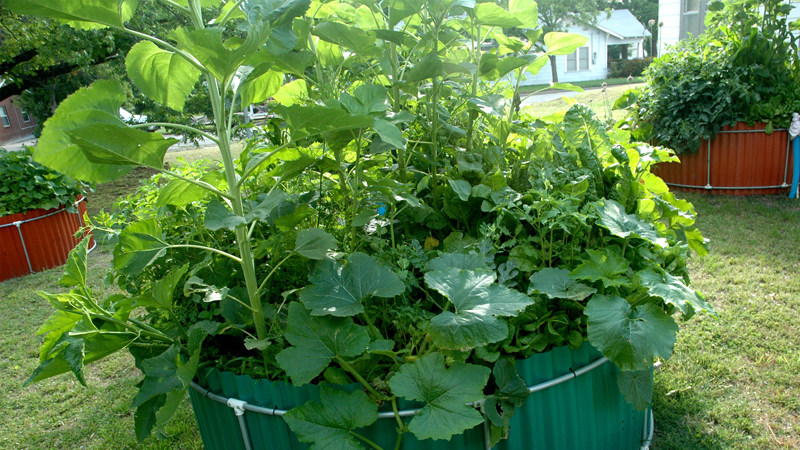As teased in our December update, a month-long experiment was conducted in January 2017 to determine if perhaps seeds planted in wood-smoked soil would do better than ones planted in regular soil, the idea being to add carbon content to the soil, since plants crave carbon. We videotaped the process, with daily updates and have composed them into a YouTube video.
The end-result of the experiment was inconclusive since some of the variety of seeds we planted did better in the smoked soil and some flourished better in the non-smoked soil, so additional experiments will be done on this, with perhaps more controls in place. It is possible that certain seeds react stronger to smoked soil than others. We’ll see.
Our experiment included these seeds: turnips, watermelons, sunflowers, tomatoes, cucumbers, okra, popcorn, kandy korn, pinto beans, lima beans, Great Northern beans, black-eyed peas, spinach, Swiss chard, cantaloupe, navy beans, pumpkins, and zucchini.
As part of the process, all except the tiniest seeds were first germinated, again using carbonated water obtained from a SodaStream machine. The germination process took three days total, although many of the seeds were ready to plant after only 24 hours. That process is included in the video as a how-to.
 If you are as anxious as I am to grow abundant and healthy crops in the spring, now is a good time to get started obtaining seeds, deciding which seeds will go where, and, as demonstrated here, germinating some seeds and beginning some starter plants.
If you are as anxious as I am to grow abundant and healthy crops in the spring, now is a good time to get started obtaining seeds, deciding which seeds will go where, and, as demonstrated here, germinating some seeds and beginning some starter plants.
Most of our experiment gardens at Keyhole Farm are mainly planted with seeds, but we often use starter tomato plants and a few others interspersed throughout the gardens. Last year, by germinating black-eyed peas in advance, we were able to plant them much earlier than usual and were harvesting them at about the same time we would normally plant them. These seeds tend to rot if planted too early, so germinating in advance helps considerably.
Now is also a good time to either construct a keyhole garden or obtain one of our easy-to-assemble, durable, lightweight kits, which are growing in popularity each year. It has been awhile since I touched on our history in an update, but eight years ago I built my first keyhole garden out of rocks and cinder blocks after reading an article published by Dr. Deb Tolman about the process.
I had extremely good luck with my first garden and swore off planting crops in the ground for several reasons. For instance, keyhole gardens conserve water, weeding is minimal with the internal basket you recycle left-overs and at the same time add nutrition to the soil which helps plants grow large and healthy plants, much of the fill in keyholes is cardboard (carbon footprint) and recycled plants (like grass clippings, leaves, twigs, etc.), and the backbreaking work is vastly reduced since you are working at a waist-high level. Additionally, seeds can be planted much closer together, making much better use of the compact space in a keyhole garden.
After that first year, I wanted another keyhole garden. My brother and I, who might be listed as semi-inventors, devised a plan to build them much easier, because he wanted one, too. Eventually, other friends and relatives wanted them, which we built during a time that we wanted to see how they held up and produced. They did quite well and a couple of years later more and more demand was being made for them, so we started Keyhole Farm, which manufactures and ships them. Orders have been filled in every state in the union and in some countries overseas. Numerous schools have obtained them to teach children the magic of raising their own crops.
 Homegrown crops are generally more tasty since you, the gardener, have control over the soil and can pinpoint the perfect time to harvest the crops, when they are at their peak. Often, stores pick crops too early in order to better maintain longer shelf life, so the interiors are not fully developed and come up short on the nutrition scale. Nutrition values can increase exponentially every day a crop is left in the soil on its way to the peak harvest time. Raising your own is also a way to avoid GMO vegetables and fruits that are often improperly labeled.
Homegrown crops are generally more tasty since you, the gardener, have control over the soil and can pinpoint the perfect time to harvest the crops, when they are at their peak. Often, stores pick crops too early in order to better maintain longer shelf life, so the interiors are not fully developed and come up short on the nutrition scale. Nutrition values can increase exponentially every day a crop is left in the soil on its way to the peak harvest time. Raising your own is also a way to avoid GMO vegetables and fruits that are often improperly labeled.
There is a link on this page that will take you to our order site if you want to obtain your own keyhole garden kit. The first kit we build seven years ago is still in operation, having survived extreme hot and cold weather, which speaks for their durability. We are a small manufacturing business with hand-tooled parts, but we ship promptly. For me, personally, I wouldn’t garden any other way. I deem keyhole gardens a near-perfect system.